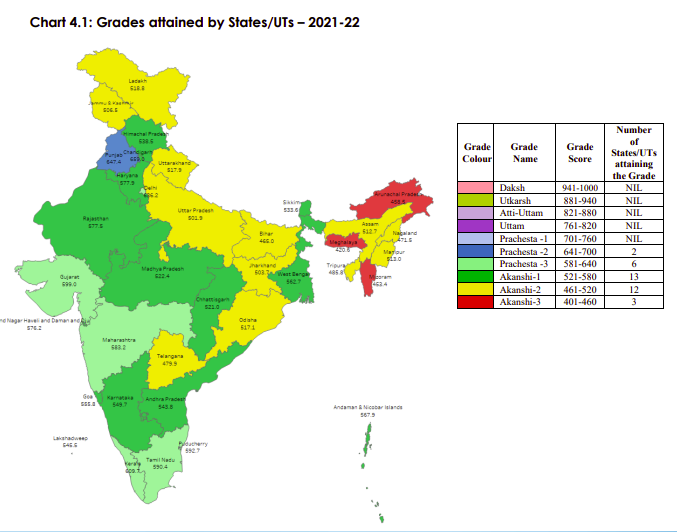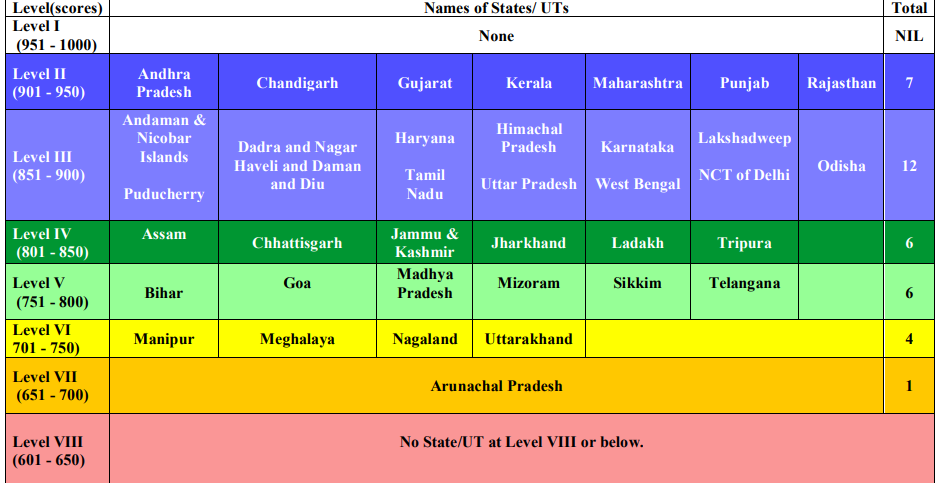Performance Grading Index on School Education of States
Performance Grading Index on School Education of States
Introduction
The Indian Education System is one of the largest in the world with more than 1.5 million schools, 8.5 million teachers and 250 million children from varied socio-economic backgrounds. The system strives to maintain standards and uniformity across the country while giving ample scope for the country’s diverse culture and heritage to grow and flourish.
The Performance Grading Index (PGI) is a tool to provide insights on the status of school education in States and UTs including key levers that drive their performance and critical areas for improvement. Department of School Education and Literacy (DoSEL) has designed the PGI to catalyse transformational change in the field of school education.
The PGI - States/UTs was first released for the year 2017-18 and so far, has been released up to the year 2021-22.
Methodology
The PGI evaluation classifies States and UTs into grade/ levels, as opposed to ranking. Grading allows several States and UTs to be considered at the same level, eliminates the phenomenon of one improving only at the cost of others, thereby casting a stigma of underperformance on the latter, though, in effect they may have maintained status quo or even performed better than earlier.
The architecture of the PGI emanates from the rationale that ensuring an efficient, inclusive and equitable school education system is contingent upon the constant monitoring of an interconnected matrix of inputs, outputs and outcomes, and the development of a quick response system for course correction.
PGI 1.0
The PGI is structured in two categories, namely, Outcomes, and Governance & Management and comprises 70 indicators These categories are further divided into 5 domains, viz., Learning Outcomes (LO), Access (A), Infrastructure & Facilities (IF), Equity (E) and Governance Process (GP). The points assigned to indicators are either 10 or 20, whereas points assigned to each Domain ranges from 80 to 360. The States and UTs have been assessed on the basis of their performance against the benchmark for each indicator. Following the same approach of State PGI in the previous years, States/ UTs are graded.
The information on the indicators are drawn from data available with the DoSEL from the Unified District Information System for Education (UDISE), National Achievement Survey (NAS) of NCERT, Mid Day Meal website, Public Financial Management System (PFMS) and the information uploaded by the States and UTs on the Shagun portal of DoSEL.
The highest achievable stage in PGI is Level I, which is for scores 951-1000. In between, an equal width of 50 points has been kept for each Level. In the PGI, Level II means PGI score 901-950, Level III: 851-900, Level IV: 801-850, and so on up to Level IX: 551-600. The last one, namely Level X is for scores 0-550.
Thus, the grading categories are relative and can change depending upon the best performers in a given year. At the same time, all 36 States and UTs can occupy the highest grade simultaneously.
PGI 2.0
To have more updated base with quality indicators, to align with new initiatives of the National Education Policy (NEP) 2020, to monitor indicators relating to Goal 4 of Sustainable Development Goals (SDGs), and to replace existing indicators which have achieved optimal target, the PGI – State structure for 2021-22 has been revised and renamed as PGI 2.0. In PGI 2.0, the data source for many of the indicators has been the data from UDISE+ and the grades have been aligned with the PGI - District to have uniformity and better comparability.
The new PGI structure covers 73 indicators, focused more on qualitative assessment besides including digital initiatives and teacher education. The grades/level obtained by States/UTs in previous edition of the PGIs are thus not comparable as with the grades/levels obtained by States/UTs in this new edition.
The PGI 2.0 structure comprises of 1000 points across 73 indicators grouped into 2 categories viz., Outcomes, Governance Management (GM). These categories are further divided into 6 domains, viz., Learning Outcomes (LO), Access (A), Infrastructure & Facilities (IF), Equity (E), Governance Process (GP) & Teachers Education and Training (TE&T).
PGI 2.0 for 2021-22 classified the States/UTs into ten grades viz., highest achievable Grade is Daksh, which is for State/UT scoring more than 940 points out of total of 1000 points. The lowest grade is Akanshi-3 which is for score up to 460. The ultimate aim of PGI 2.0 is to propel States & UTs towards undertaking multi-pronged interventions that will bring about the much-desired optimal education outcomes covering all dimensions. Indicators of PGI 2.0 have been aligned to policy initiatives and interventions introduced post implementation of National Education policy (NEP) 2020 for proper tracking the progress. The PGI 2.0 is expected to help States and UTs to pinpoint the gaps and accordingly prioritize areas for intervention to ensure that the school education system is robust at every level.
Performance of states and UTs 2021-22
- None of the States/UTs has attained the highest Grade i.e., Daksh. The top-most grade attained in PGI 2.0 is Prachesta - 2, i.e., score range 641-700 indicating that a good proportion of score of the redundant indicators was contained in the total scores of States/UTs in the previous years.
- Grade attained by States /UTs in 2021-22 - Only 2 States and UTs, namely Punjab and Chandigarh have attained Grade Prachesta -2 (score 641-700) in PGI 2.0. 6 States/UTs joined Grade Prachesta - 3 (score 581- 640), 13 States/UTs joined grade Akanshi -1 (score 521-580), 12 States/UTs in grade Akanshi - 2 (score 461-520) and 3 States in grade Akanshi – 3 in PGI 2.0.
- To view the full report, click here.

Performance of states and UTs 2020-21
- A total of 7 States and UTs, namely Kerala, Punjab, Chandigarh, Maharashtra, Gujarat, Rajasthan, and Andhra Pradesh have attained Level II (score 901-950) in 2020-21 as compared to none in 2017-18.
- 12 States/UTs joined Level III (score 851-900), 6 States/UTs joined Level IV (score 801-850), 6 States in Level V (score 751-800), 4 States in Level VI and one State viz., Arunachal Pradesh stayed in Level VII (score 651-700) in PGI 2020-21.
- A total of 27 States and UTs have improved their total PGI score in 2020-21 as compared to 2019-20.
PGI Levels attained by various States/UTs in 2020-21

Inter-State Disparity:
The maximum and minimum scores obtained by State in 2020-21 are 928 and 669 respectively. The deviation between the maximum and minimum scores obtained by States is 259 or 39 %, of the minimum points, indicating that, State Arunachal Pradesh has to put more efforts to reach the top slot. This disparity was 51 % in 2017-18 indicating that, PGI also helped to bridge the performance gap among States/UTs over the years which may be due to efforts of the Government such as look East policy. The reduction in Inter-State differential is also due to close monitoring of schemes through evidence based PGI which might have helped both the performing and aspiring States and UTs to improve their performance.
Best Achievers vis-à-vis the Ultimate Goal:
In 2020-21, a total of 7 States/UTs reached Level II (score 901– 950) up from 5 States/UTs in 2019-20 and no State/UT in Level 2 till 2018-19. More heartening fact is that, no State figured in the bottoms 3 Levels in 2020-21 as against 2 States in bottom 3 Levels in 2019-20. The most significant performer in 2020-21 is Ladakh which has attained the Level 4 in 2020-21 from Level 10 in 2019-20 might be due to focused attention of UT administration on School education. Other notable outcome of PGI 2020-21 is that 7 States/UTs namely Gujarat, Andhra Pradesh, Maharashtra, Chandigarh, Punjab, Kerala and Rajasthan have achieved 900 plus scores in 2020-21 indicating desires among States to secure top slot.
Size vis-a-vis Performance:
The Performance of a State/UT is often perceived to be linked to the size (geographical area) of the State/UT as it has a bearing on several logistic, administrative and other issues. However, size does not appear to be a determining factor in the performance of States and UTs in the field of School Education as assessed by the PGI. Thus, Rajasthan, Maharashtra, Gujarat, Andhra Pradesh, Punjab, Kerala, and Chandigarh which are in Level 2, are ranked 1st, 3rd, 5th, 7th, 20th, 23rd, and 35th respectively in terms of their geographical size among States/UTs. Similarly, the States which are in Level VI and VII are ranked 14th (Arunachal Pradesh), 19th (Uttarakhand), 24th (Meghalaya), 25th (Manipur), and 27th (Nagaland) respectively in terms of geographical size.
Domain-wise analysis
A Domain-wise analysis also brings out some areas of general concern for all the States and UTs. In 2020-21, the top score in the Domain relating to Governance & Processes (346, Punjab) has crossed 90% of the maximum points (360) whereas three States/UTs, Viz., Ladakh (76), Chhattisgarh (169) and Nagaland (174) have scored less than 50% of the maximum possible score in this domain. Moreover, in the domain Governance Processes, there are 24 States/UTs which have scored less than 288 (80% of the maximum possible score). It clearly implies that this is the area many States and UTs must focus upon. The PGI too accords the highest importance to this Domain because compliance with the indicators here will lead to critical structural reforms in areas ranging from monitoring the attendance of teachers to ensuring a transparent recruitment of teachers and principals.
Way Ahead
To align with NEP 2020 initiatives, the PGI Report for 2021-22 will be revamped by adding new indicators to expand the coverage without altering total points. By doing so, Domains such as teachers, digital education, learning outcome etc will get enhanced weight in the Index. The revamped PGI 2021-22 will replace the redundant and saturated indicators. The marking system will also undergo changes making it more specific. The classification of points obtained by States/UTs will also be converged to the new classification adopted in PGI District structure.
Source: Department of School Education & Literacy
Related resources
Last Modified : 7/9/2023
This topic provides best practices related to lear...
This topic provides information about Remote learn...
This topic provides information about Remote learn...
This topic provides information about Remote learn...
